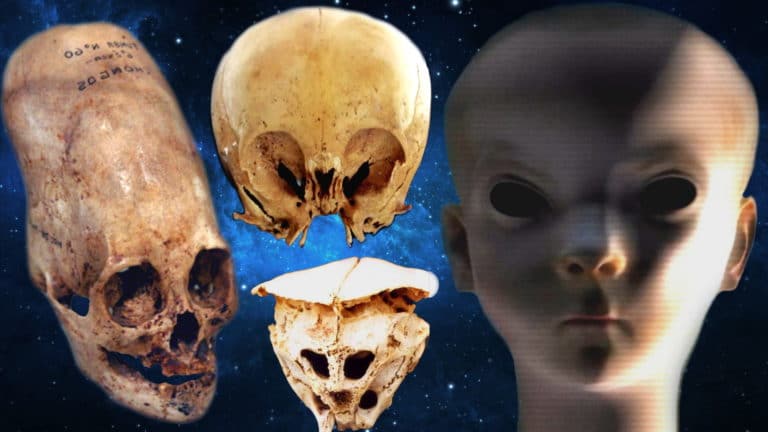If you’re fascinated by the wonders and mysteries of archaeology, you’ve no doubt come across stories of strange skulls that have been unearthed around the world. Many of these skulls look nothing like a typical human skull, leaving us with more questions than answers about the races and civilizations that came before us.
Elongated Skulls from Paracas
Back in 1928, archaeologist Julio Tello made one of the most fascinating discoveries on the southern coast of Peru. There, at the desert peninsula of Paracas, a mysterious and seemingly sophisticated cemetery was found. In the tombs, 30 feet deep into the bedrock, archaeologists discovered ancient mummies of an unknown race with unnatural skulls that challenged everything we know about human evolution. Over 300 of these mummies, all with strange and unnatural skulls, were found at the site, and after further research, it’s believed they date back to over 3,000 years.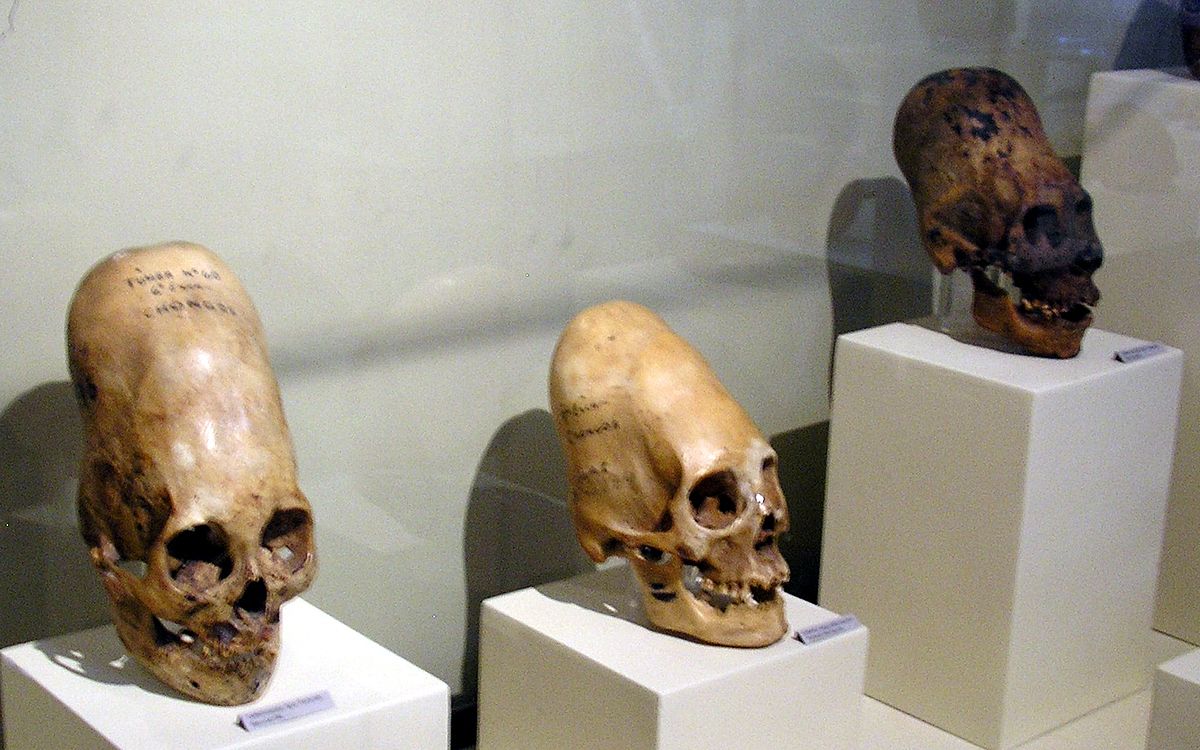 Although the elongated skulls were reaching much higher than the average human skull of today, scientists first thought that the skulls belonged to a culture that practices skull deformation.
Throughout history, many cultures have practiced artificial cranial deformations, so it wasn’t that unusual. From the nomadic Huns of the Eurasian steppes to the Maya and Inca tribes of North America, many of them performed this custom.
They applied constant pressure over the soft skulls of babies using ancient tools or wrappings. In time, these babies would grow with drastically elongated skull shapes. However, this type of cranial deformation can only change the shape of the skull and cannot alter the cranial size, volume, or weight, which are characteristic features of a regular human skull.
Upon further analysis, however, it seemed that the Paracas skulls of Peru are not artificially deformed, as they are 60% heavier and 25% larger than the skulls of human beings, while also having a bigger volume. These characteristics could not be achieved with artificial skull deformation. The massive size of cranial capacity is evidence that the brains of these beings were much bigger than ours, almost three times larger than human brains, suggesting that the beings were much more intelligent than us.
Even their skull structure was different as they have one parietal bone, while humans have two, meaning that the Paracas skulls didn’t have a sagittal suture which is the connective tissue join found between the parietal plate bones in all human skulls. The skulls also have two holes in the back called foramen, through which nerve and blood flow occur.
Although the elongated skulls were reaching much higher than the average human skull of today, scientists first thought that the skulls belonged to a culture that practices skull deformation.
Throughout history, many cultures have practiced artificial cranial deformations, so it wasn’t that unusual. From the nomadic Huns of the Eurasian steppes to the Maya and Inca tribes of North America, many of them performed this custom.
They applied constant pressure over the soft skulls of babies using ancient tools or wrappings. In time, these babies would grow with drastically elongated skull shapes. However, this type of cranial deformation can only change the shape of the skull and cannot alter the cranial size, volume, or weight, which are characteristic features of a regular human skull.
Upon further analysis, however, it seemed that the Paracas skulls of Peru are not artificially deformed, as they are 60% heavier and 25% larger than the skulls of human beings, while also having a bigger volume. These characteristics could not be achieved with artificial skull deformation. The massive size of cranial capacity is evidence that the brains of these beings were much bigger than ours, almost three times larger than human brains, suggesting that the beings were much more intelligent than us.
Even their skull structure was different as they have one parietal bone, while humans have two, meaning that the Paracas skulls didn’t have a sagittal suture which is the connective tissue join found between the parietal plate bones in all human skulls. The skulls also have two holes in the back called foramen, through which nerve and blood flow occur.
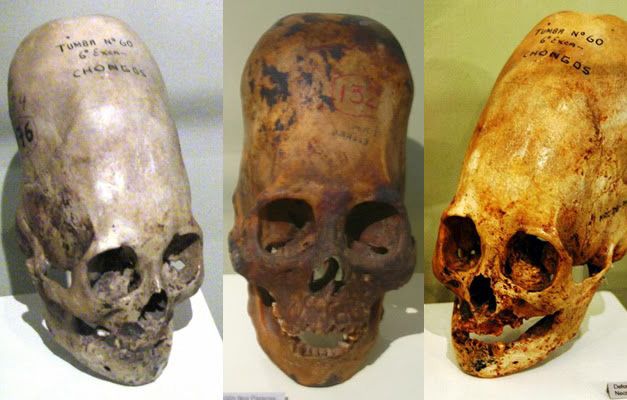 The elongated shape was not the only thing to gain attention about the appearance of the skulls. In fact, some of the skulls also had different eye sockets alongside the cone shape of the skull. Eyesockets that are seemingly different and slightly larger than those of humans, meaning that the beings’ eyes were very dissimilar to ours. Their jaws were also very robust compared to human jaws.
While the shape of the skulls was one of the things that gained the most attention at the time, further research has been conducted more recently on their DNA, after the Paracas Museum of History examined samples consisting of skin, teeth, hair, and fragments of the skull bones. The results were astonishing.
They uncovered that the mitochondrial DNA showed mutations that had never been seen in any living creature on Earth before. In fact, this led to the conclusion that the skulls that had been uncovered could be from a whole new race of beings, very possibly a race of extraterrestrial beings, or some sort of hybrid species.
Brien Foerster, a Paracas Museum assistant and an expert on ancient elongated skulls, made the following statement regarding the tested skull:
The elongated shape was not the only thing to gain attention about the appearance of the skulls. In fact, some of the skulls also had different eye sockets alongside the cone shape of the skull. Eyesockets that are seemingly different and slightly larger than those of humans, meaning that the beings’ eyes were very dissimilar to ours. Their jaws were also very robust compared to human jaws.
While the shape of the skulls was one of the things that gained the most attention at the time, further research has been conducted more recently on their DNA, after the Paracas Museum of History examined samples consisting of skin, teeth, hair, and fragments of the skull bones. The results were astonishing.
They uncovered that the mitochondrial DNA showed mutations that had never been seen in any living creature on Earth before. In fact, this led to the conclusion that the skulls that had been uncovered could be from a whole new race of beings, very possibly a race of extraterrestrial beings, or some sort of hybrid species.
Brien Foerster, a Paracas Museum assistant and an expert on ancient elongated skulls, made the following statement regarding the tested skull:
“It had mtDNA (mitochondrial DNA) with mutations unknown in any human, primate, or animal known so far. But a few fragments I was able to sequence from this sample indicate that if these mutations hold, we are dealing with a new human-like creature, very distant from Homo Sapiens, Neandertals, and Denisovans. I am not sure it will even fit into the known evolutionary tree.”All of this leaves us wondering where did these beings come from, how did they look like, and where did they disappear? And did ancient humans interact with them in any way?
Ancient Gods and Creators of Civilizations
We already mentioned that many civilizations practiced skull deformation on almost every continent of the planet. The question is, why? Why would people want to elongate the heads of their children? Is it possible that primitive humans were trying to imitate the appearance of the elongated skull beings, who were probably more advanced and more intelligent than them? And the cultures that didn’t practice artificial skull elongation simply wore headwear that made them seem like they had elongated skulls. In the region of Mesopotamia, the rulers and royalties of all ancient civilizations were wearing elongated headwears – ancient Sumerians, Akkadians, Babylonians, and Assyrians. And in Ancient Egypt, we see the exact same thing with Pharaohs and Queens. These elongated headwears continued even to the Medieval era, where every pope was wearing a papal tiara. The Papal tiara was last used by Pope Paul VI in 1963. Is it possible that the first sophisticated human civilizations were ruled by these more intelligent beings with elongated heads and brains the size of three human brains? Perhaps this could explain the rapid advancement in technology we see in the Sumerian civilization, kickstarting the development of human society. And at some point, when these hybrids, or perhaps entirely extraterrestrial beings, departed Earth and left humans to rule themselves, the humans tried to mimic their appearance in order to enforce their rule. They tried to look more like the highly intelligent beings that gave them the secrets of building a structural society and sedentary culture. Is this the reason absolutely every society was ruled by royal bloodlines and dynasties? Is it possible that hybrid bloodlines were left on Earth to rule the humans under a strict aristocratic hierarchy? And if that’s the case, is there any evidence of such hybrid rulers?Queen Puabi’s Skull
In 1927, after an advanced excavation project at the ancient Sumerian city of Ur in Mesopotamia, British archaeologist Sir Charles Leonard Woolley discovered the remains of the Sumerian Queen Puabi.The reports state that the skull of the queen was unnaturally large compared to the skull of a normal human being. The queen died 4,500 years ago during the First Dynasty of Ur, and she was also considered a “nin”, calling her Nin-Puabi, which is a Sumerian term for goddess.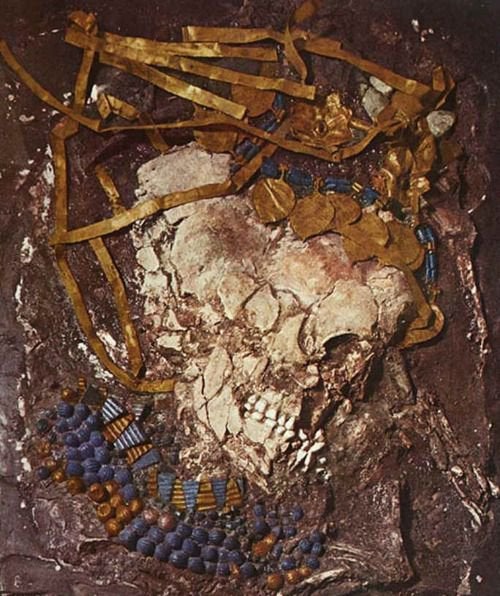 This led many people to believe that the skull of queen Puabi is another evidence of the extraterrestrial and hybrid links to our ancient history.
One of these people was Zacharia Sitchin, the man who first came with the Ancient Astronaut Theory and stated that the Sumerian gods known as Anunnaki were actually ancient extraterrestrial visitors. He believed that Queen Puabi’s genome could contain the signature of the Anunnaki race and their hybrid creations.
Sitchin, who was ridiculed by the scientific establishment for his bold claims, stated that he’s willing to stake everything he’s written about the Anunnaki and his ancient astronaut theory on DNA tests that could be performed on the 4,500-year-old remains of the Sumerian queen. Despite all of his requests, the British Museum never allowed DNA testing on the remains of the skull.
Today, Nin-Puabi’s skull is almost completely extirpated. The remains continue to be kept at the London Museum of Natural History, with DNA analysis requests firmly denied by the British Museum.
Why would they deny DNA testing? Are they trying to hide something from us?
With more questions than answers, it leaves us wondering what other similar cases and strange discoveries have been found around the world?
How many unnatural skulls are out there?
This led many people to believe that the skull of queen Puabi is another evidence of the extraterrestrial and hybrid links to our ancient history.
One of these people was Zacharia Sitchin, the man who first came with the Ancient Astronaut Theory and stated that the Sumerian gods known as Anunnaki were actually ancient extraterrestrial visitors. He believed that Queen Puabi’s genome could contain the signature of the Anunnaki race and their hybrid creations.
Sitchin, who was ridiculed by the scientific establishment for his bold claims, stated that he’s willing to stake everything he’s written about the Anunnaki and his ancient astronaut theory on DNA tests that could be performed on the 4,500-year-old remains of the Sumerian queen. Despite all of his requests, the British Museum never allowed DNA testing on the remains of the skull.
Today, Nin-Puabi’s skull is almost completely extirpated. The remains continue to be kept at the London Museum of Natural History, with DNA analysis requests firmly denied by the British Museum.
Why would they deny DNA testing? Are they trying to hide something from us?
With more questions than answers, it leaves us wondering what other similar cases and strange discoveries have been found around the world?
How many unnatural skulls are out there?
Horned Skulls of Pennsylvania
For example, take this giant horned skull found in the 1880s in Sayre, Pennsylvania.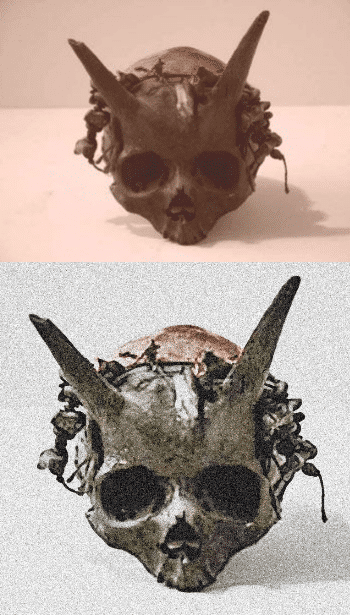 An archaeologist uncovered multiple skulls in a burial mount dating back to the 11 or 12th century AD. Although the skulls had features very similar to human skulls, several of them had horns, two inches above the eyebrows.
On top of that, research suggested that these skulls would make the average height of their owner around seven feet, which is 213 centimeters. This height is very unusual for the 11th century and even for today’s standards.
The skulls were sent to the American Investigation Museum in Philadelphia, and after months of investigations, it was stated that they had been stolen or lost from the museum. This left many curious investigators wondering who these skulls belonged to and where did they disappear. Many dismiss this story as a hoax as the only available evidence is the photograph of one of the skulls, but others believe it was covered up, and the skulls were hidden from the public.
An archaeologist uncovered multiple skulls in a burial mount dating back to the 11 or 12th century AD. Although the skulls had features very similar to human skulls, several of them had horns, two inches above the eyebrows.
On top of that, research suggested that these skulls would make the average height of their owner around seven feet, which is 213 centimeters. This height is very unusual for the 11th century and even for today’s standards.
The skulls were sent to the American Investigation Museum in Philadelphia, and after months of investigations, it was stated that they had been stolen or lost from the museum. This left many curious investigators wondering who these skulls belonged to and where did they disappear. Many dismiss this story as a hoax as the only available evidence is the photograph of one of the skulls, but others believe it was covered up, and the skulls were hidden from the public.
Rhodope Skull of Bulgaria
There are other similar cases cited from areas around the world, like the Rhodope skull found in the Rhodope mountain of Bulgaria.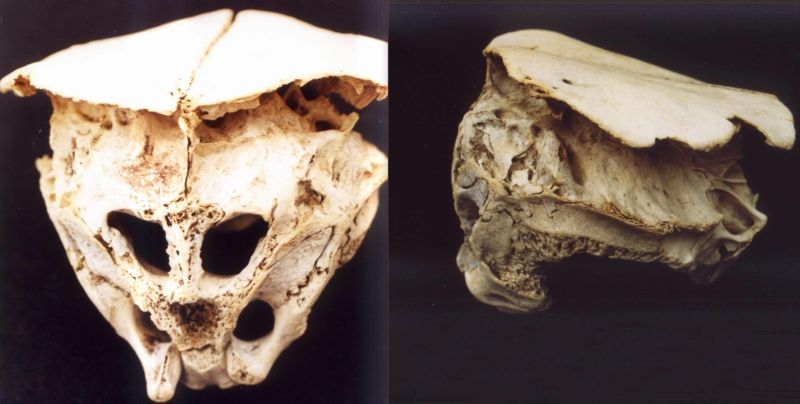 This is one of the most mysterious skulls ever discovered, as it doesn’t look remotely close to any other known species on our planet. It’s unknown whether this skull is of a humanoid creature or some sort of unknown animal. Unlike the horned skulls, however, this skull received high publicity in Bulgaria, as the discovery was mentioned in the most prominent news media of the country.
Dimitar Kovachev, the Director of the Paleontological Museum of Asenovgrad, is certain that the discovery is no fossil and is of a species unknown to science.
The strange skull has six cavities which, seem to be where the creature’s sensory organs resided. Judging by the formation of the skull, the being could have had up to six eyes or other unknown organs.
This is one of the most mysterious skulls ever discovered, as it doesn’t look remotely close to any other known species on our planet. It’s unknown whether this skull is of a humanoid creature or some sort of unknown animal. Unlike the horned skulls, however, this skull received high publicity in Bulgaria, as the discovery was mentioned in the most prominent news media of the country.
Dimitar Kovachev, the Director of the Paleontological Museum of Asenovgrad, is certain that the discovery is no fossil and is of a species unknown to science.
The strange skull has six cavities which, seem to be where the creature’s sensory organs resided. Judging by the formation of the skull, the being could have had up to six eyes or other unknown organs.

